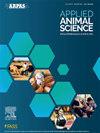Review: Production and prediction of enteric methane in dairies in the Texas Panhandle and surrounding areas
IF 1.5
Q3 AGRICULTURE, DAIRY & ANIMAL SCIENCE
引用次数: 0
Abstract
Purpose
We reviewed the current understanding of methane production, prediction, and mitigation strategies in dairy cattle located in the Texas Panhandle and surrounding High Plains region.
Sources
Peer-reviewed literature was the primary source of information.
Synthesis
The dairy industry in the Texas Panhandle and surrounding High Plains region has expanded greatly in recent decades, reflecting a geographic shift from historically significant dairy production areas in Central and Northeast Texas and states in the Western United States. Along with this geographic shift, the US dairy cattle population has decreased 4.5% since 1990. Nonetheless, enteric CH4 emissions increased 13% from 1990 to 2022. Enteric CH4 emissions can be affected by numerous diet- related factors including feed intake, diet composition, and feed additives (hydrogen sinks and direct inhibitors) that alter CH4 production in the gastrointestinal tract. Accurate, direct estimates of enteric CH4 emissions are challenging and costly to measure from individual animals, which has resulted in the use of mathematical models as a means to predict CH4 emissions in dairy cattle. We evaluated commonly used equations to predict CH4 emissions in lactating cows, nonlactating cows, and growing heifers when applied to diets and performance typical of dairies in the Texas Panhandle. The CH4 emissions (g/d) among the 3 equations used with 3 lactating cow diets ranged from 431 to 507 g/d. Additionally, the CH4 emissions among the 2 equations used with 3 dry cow diets ranged from 251 to 278 g/d. For dairy heifers, CH4 emissions among the 2 equations used with 3 growing heifer diets ranged from 157 to 175 g/d. Predicted CH4 yield for equations and diets used ranged from 17.8 to 20.9 g/kg of DMI for lactating cows, 17.9 to 19.8 g/kg of DMI for dry cows, and 14.6 to 20.2 g/kg of DMI for growing heifers.
Conclusions and Applications
Dietary factors affecting enteric CH4 production are generally well defined. Moreover, potential mitigation strategies exist to decrease CH4 emissions, but our ability to accurately and precisely predict feed intake and digestibility, which are major factors affecting CH4 production, needs improvement. Future research measuring enteric CH4 emissions from cows fed diets typical of those used in the Texas Panhandle and High Plains region across a range of DMI would be useful to validate and potentially improve existing prediction equations for their utility in these regions. Improvement in predicting enteric CH4 emissions will allow dairies to address potential regulatory challenges and understand practical effects of mitigation approaches.
综述:德克萨斯州狭长地带及周边地区奶牛场肠道甲烷的产生与预测
目的综述了目前对德克萨斯州狭长地带及周边高平原地区奶牛甲烷产生、预测和缓解策略的了解。资料来源同行评议的文献是主要的资料来源。近几十年来,德克萨斯州狭长地带及其周边的高平原地区的乳制品工业得到了极大的发展,这反映了德克萨斯州中部和东北部历史上重要的乳制品生产区和美国西部各州的地理变化。随着这种地理位置的变化,美国奶牛的数量自1990年以来减少了4.5%。尽管如此,从1990年到2022年,肠道甲烷排放量增加了13%。肠道CH4排放可受到许多与饲料有关的因素的影响,包括采食量、饲料成分和饲料添加剂(氢汇和直接抑制剂),这些因素会改变胃肠道中CH4的产生。准确、直接地估计奶牛肠道内CH4的排放量具有挑战性,而且成本高昂,因此需要使用数学模型作为预测奶牛体内CH4排放量的手段。我们评估了用于预测泌乳奶牛、非泌乳奶牛和生长中的小母牛的CH4排放的常用方程,并将其应用于德克萨斯州狭长地区典型奶牛的日粮和生产性能。3种奶牛日粮的CH4排放量(g/d)在431 ~ 507 g/d之间。3种干牛日粮的CH4排放量在251 ~ 278 g/d之间。对于奶牛,3种生长中的母牛日粮所使用的2个方程的甲烷排放量在157 ~ 175 g/d之间。计算公式和饲粮对CH4产量的预测范围分别为:泌乳奶牛17.8 ~ 20.9 g/kg DMI,干奶牛17.9 ~ 19.8 g/kg DMI,生长母牛14.6 ~ 20.2 g/kg DMI。影响肠道CH4产生的膳食因素通常是明确的。此外,存在减少CH4排放的潜在缓解策略,但我们准确预测采食量和消化率的能力需要提高,这是影响CH4产生的主要因素。未来的研究将通过一系列DMI来测量饲喂德克萨斯州狭长地区和高平原地区典型饲料的奶牛的肠道CH4排放量,这将有助于验证和潜在地改进现有的预测方程,以使其在这些地区的实用性。改善对肠道甲烷排放的预测将使奶牛场能够应对潜在的监管挑战,并了解缓解方法的实际效果。
本文章由计算机程序翻译,如有差异,请以英文原文为准。
求助全文
约1分钟内获得全文
求助全文

 求助内容:
求助内容: 应助结果提醒方式:
应助结果提醒方式:


